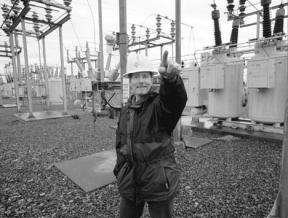March Point has probably taken more than its share of blame for plunging homes and businesses into darkness over the past few years.
For most people, the name doesn’t mean much: It’s just a location where power outages happen.
This winter, which has been unusually mild in terms of both weather and power outages, March Point is almost completely forgotten.
What it is in reality not glamorous, though it is incredibly important to almost every person living or doing business on Whidbey Island. Located just off Highway 20, close to the Anacortes turnoff to Whidbey Island and hidden behind an old church, March Point is an electrical substation owned by Puget Sound Energy. Routing high-energy power lines from Sedro Woolley and hydroelectric dams further east, it’s the last stop for what may be the longest extension cord in the continental United States.
Whidbey Island is unique in the PSE system, said company spokesperson Karl Kirn this week. Two transmission lines running the 41-mile length of the island are vulnerable to tree and wind damage in many places due to the island’s geography, he said, but are backed up more extensively than almost any other PSE owns. He said the distance spanned by the lines is comparable to another PSE link, one between Bellevue and Olympia.
The lines on the island, he said, have to be more reliable because they are more isolated.
“You there on the island have the Cadillac of systems in the company,” he said.
Even so, the power goes out from time to time. Ron Forester, the PSE engineer who oversees the island’s power system and March Point, said it has been several years since the 80-year-old substation has been directly responsible for a power outage. Occasionally line damage will cause a problem at the station and cause portions of the distribution network in the Whidbey Island and Anacortes areas to go down. But he said, pointing at 60-year-old transformers during a tour through the substation this week, equipment other than lines is rarely the problem.
“What we worry about here is two lines out at the same time,” he said.
He needs to, since this still happens more than PSE officials would like. Dorothy Bracken, another PSE spokesperson, said the last time this happened on a regular basis, during a stormy, February and March in 1999, all of Whidbey Island was in the dark for up to a day at a time.
In most places in the PSE system, power lines and other power grid components well separated and placed away from hazards. But from March Point south to Clinton, geography, Deception Pass State Park and other choke points bring the lines together in six spots, including Greenbank and Freeland.
The reliability of the lines has been fairly high since PSE energized a high-power line between Freeland and Clinton to complete a two-line “loop” on Whidbey Island. Forester said that loop ensures that the power will stay on even if falling tree or wind takes down a single line.
But, in the case of severe winter weather, that’s no guarantee. Even during those five years, tree falls have not only taken the two lines down together, but separately.
The March Point portion of the system, which includes a natural-gas fired generating plant at Fredonia, supplies Whidbey Island with up to 140 megawatts of power at peak energy use times. Forester said that is enough power to supply 100,000 homes.
Kirn said PSE had expected weather this winter to cause a number of major outages on Whidbey Island. But storm winds have largely missed the island, sparing it — and the much maligned March Point substation — from any large outages.


